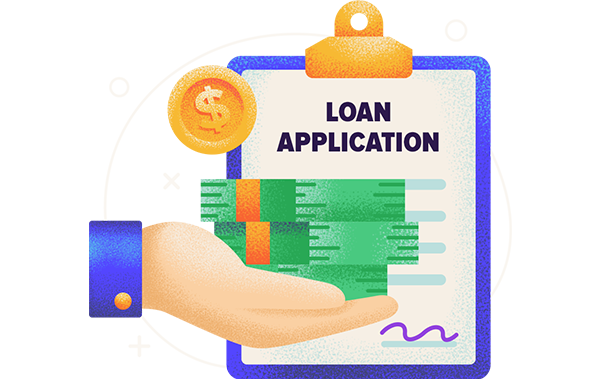To get a personal loan, consumers should first check their credit score and check for pre-qualification, then compare offers based on APRs, fees, loan sizes and approval requirements.
How to Get a Personal Loan in 6 Steps
- Check your credit score
- Check for pre-qualification
- Compare offers and select the one with the best terms (APR, fees, etc.)
- Fill out an application, online if possible
- Wait for a decision, which usually takes a few business days
- Receive a bank transfer for the loan amount, usually within 7 business days of applying
While figuring out how to get a personal loan can seem difficult at first, following these six simple steps can make the process a lot easier. Below, is an in-depth breakdown of each step.
1. Check Your Credit Score
In order to get a personal loan you first need to check your credit score so that you can identify which lenders offer loans that are within your reach. The higher your credit score is, the more loans you’ll qualify for and the better terms you’ll get.
Key Facts About Personal Loans and Credit Scores
- The best personal loan providers have minimum credit score requirements ranging from 585 to 700+.
- To qualify for a personal loan without an origination fee (a fee to open the loan), you will likely need a credit score of 660+.
- Banks tend to have the strictest credit score requirements, while there are more online lenders and credit unions willing to work with people who have bad credit.
- Some personal loans don’t do a credit check, but they tend to have extremely high APRs as a result.
You can check your credit score for free with WalletHub. It’s also a good idea to take a look at your credit report and dispute any errors before applying.
2. Check for Pre-Qualification
Pre-qualification is a way to check how likely you are to get approved for a personal loan without actually applying. You just have to give the lender some basic personal information like your name, address and Social Security number. Then, the lender will let you know whether you’re likely to be approved for a loan, as well as what rates you’re likely to receive.
Key Facts About Pre-Qualification
- Pre-qualification will not affect your credit because the lender only uses a soft credit pull during the process.
- If you are pre-qualified, you won’t necessarily be approved when you apply. But your chances are about as high as they can get.
- There’s no obligation to actually submit an application after you’re pre-qualified.
- You can pre-qualify with as many lenders as you want.
If you want to speed up the pre-qualification process, you can use WalletHub’s free pre-qualification tool to check with multiple lenders at once.
3. Compare Offers
Once you know your credit score and have pre-qualified with a few different lenders, you’re ready to compare personal loan offers based on the terms you pre-qualified for. There are a lot of different things to consider when deciding which loan offer is the best, from APRs to how long approval takes.
Important Things to Compare When Getting a Personal Loan
- APRs (typically range from 4% to 36%)
- Fees (origination fees, late fees, prepayment fees, etc.)
- Payoff periods (usually range from 12 to 84 months)
- Dollar amounts available (typically range from $1,000 to $100,000)
- Approval and funding timeline (most loans offer funding in 7 business days or fewer)
- Credit score requirements
- Other requirements (income, SSN, citizenship, etc.)
The best personal loan for you will probably be the one that is likely to offer the lowest rates and fees. However, other terms can definitely impact your decision – for example, if you need a quick loan, the approval timeline may play a bigger part than usual.
4. Fill Out an Application
Once you’ve decided on the best personal loan, it’s time to fill out an application. When you apply, it’s best to do so online. That way, you’ll have the potential for the fastest decision possible. You may also have the option to apply over the phone, in person or by mail, depending on the lender.
The application will ask for basic personal information like your name and address, plus financial information like your income, employment status and monthly housing payment.
Things Usually Included on a Personal Loan Application
- Name
- Address
- Date of birth
- Social Security number
- Citizenship status
- Purpose of the loan
- Income
- Employment status
- Housing status and monthly cost
- Co-signer’s information (if applicable)
Be sure to fill out everything on your personal loan application accurately and truthfully. It’s illegal to knowingly enter false information, and making a mistake or leaving something incomplete can delay your decision.
5. Wait for a Decision
Once you’ve submitted an application, all that’s left is to wait for a decision. It could happen nearly instantly or it could take a few weeks, depending on how well you meet the loan’s credit and income requirements and how quickly the lender can verify your personal information.
Key Things to Know About Personal Loan Decisions
- Most personal loans should approve or deny you within a few business days after you’ve submitted the application.
- If you’re denied, it’s best to wait at least six months before submitting another application. That gives your credit score time to recover from the hard pull caused by the first application, though waiting might not be possible if the loan is urgent.
- If you’re approved for a loan, congratulations! All you have to do is sit back and wait for your funds to come in.
6. Receive the Funds
Once you get approved for a personal loan, the lender will usually send you a bank transfer for the amount of the loan. You might also have the option to get your money through a paper check.
Key Things to Know About Personal Loan Funding
- Getting your funds through a bank transfer typically takes at least one business day after approval. In rare cases, same-day funding may be available.
- You can typically expect your personal loan to get funded within seven business days after you submit your application, though it can take longer, depending on the lender.
- If you choose to get your money through a check, it will take several additional business days to arrive by mail.
- Once you have the funds, you’re free to use them for just about anything you want.
Tips for Getting a Personal Loan
-
Consider multiple types of lenders.
You can get a personal loan from a bank, credit union or online lender. Each has its own advantages and disadvantages, so it’s important to compare offers from all of them before deciding on a loan.
-
Pick up funds in person.
It usually only takes one or two business days after approval for your personal loan funds to be delivered to your account. But if you get a loan from a bank or credit union, going in person to pick up a check might be faster.
-
Raise your credit and/or income.
If your personal loan isn’t urgent, taking time to improve your credit score or make a little extra money can help you qualify for better loans with lower rates.
-
Manage the loan responsibly.
Pay on time every month, and pay more than the monthly minimum if you’re able. That will decrease the amount of interest you owe in the long run because you will pay off the loan sooner. The vast majority of lenders do not charge any kind of fee for paying off your loan earlier than required.
-
Get pre-qualified.
Pre-qualification gives you an idea of your approval odds and potential rates before you apply. Applying for a loan you’re pre-qualified for may help speed up the process since you’re very likely to get approved. It’s also a good way to ensure you get the best loan.
-
Check your credit score.
If your credit score is well above the lender’s minimum requirements, you have a much better chance of getting approved – and getting approved quickly. You can check your credit score for free on WalletHub.
-
Apply online.
Online applications generally receive the fastest decisions. And lenders that conduct all of their applications online are especially streamlined.


WalletHub experts are widely quoted. Contact our media team to schedule an interview.